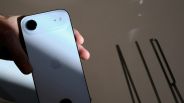-
Man's Runny Nose Turns Out To Be Leaking Brain Fluid
-
Milk Allergy The Most Common Allergy In Kids, Many Are Undiagnosed: Study
-
Parents Sucking Their Baby's Pacifier Clean Prevents Allergies: Study
-
NFL Pours $35 Million Into Research On Neuroscience
-
DOD Sponsored Research Shows Meditation Can Help People With PTSD
-
CDC Report Shows Increasing Suicide Rates Among American Workers
-
Teen Dies After 'Huffing' Deodorant Spray To Get High
-
People Sensitive To Caffeine's Bitterness Drink More Coffee: Study
-
Raccoons Thought To Be Rabid Actually Drunk On Fermented Crabapples
-
Low-Carb Diets Effective At Maintaining Healthy Body Weight Says Study
-
New Guidelines Want Doctors To Screen Adults For Unhealthy Alcohol Use
-
Pneumonia Caused By Bacteria More Dangerous To Cardiovascular Health Than Viral Pneumonia
Most Popular




